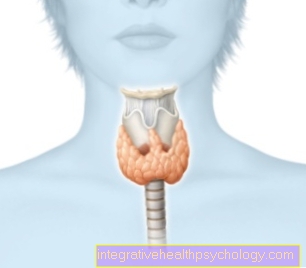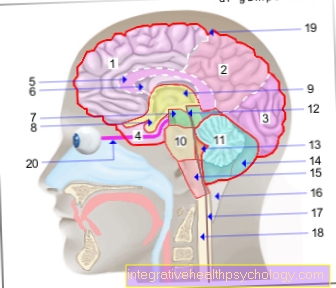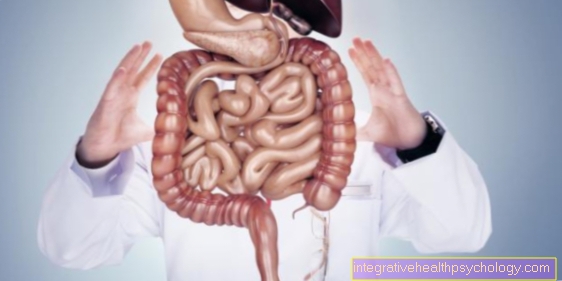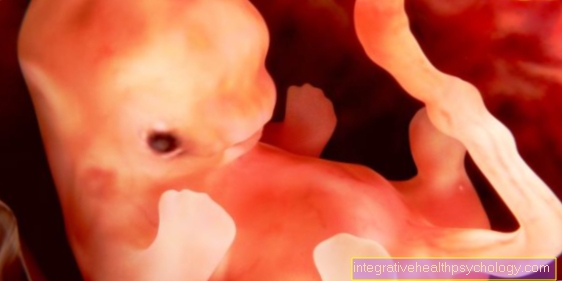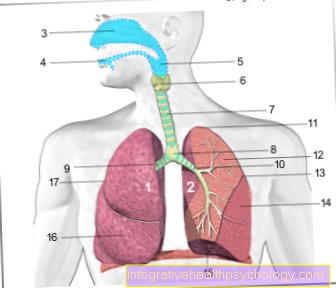End-stage glioblastoma
introduction
Glioblastoma is probably the most aggressive brain tumor and is associated with a poor prognosis for patients.
The disease cannot be cured and, even under therapy, those affected die very early.
The WHO (World Health Organization) assigns grade IV to glioblastoma. This is the highest grade that can be assigned to a brain tumor based on the severity of the condition.

Depending on the type of glioblastoma, survival time under therapy can range from a few months to 2 years. The end stage of this life-threatening disease is characterized by distressing symptoms, in which the goal of therapy is to alleviate the suffering.
The following article takes a closer look at important aspects relating to the topic of "terminal glioblastoma".
Read more on the topic: Glioblastoma - course of the individual stages
Duration of the final stage
It is very difficult to give an exact duration for the end stage of glioblastoma, since the end stage is not defined in time either.
The time transitions are therefore fluid. Basically, the end stage is to be seen as a section of the course of the disease in which the disease is only treated palliatively and no longer curatively.
This means that the aim of therapy is not healing, but alleviating the symptoms and ensuring quality of life.
In the case of glioblastoma, however, therapy is never intended to be curative, as the disease is incurable. The final stage represents the last months and weeks of life. Accordingly, the duration of the final stage varies between a few weeks and months.
Signs of terminal glioblastoma
The symptoms of a glioblastoma cannot always be definitely assigned to a stage. Depending on the size and location of the tumor, the symptoms can vary from patient to patient. In the terminal stages, however, a glioblastoma can often grow to a considerable size, which can cause unpleasant symptoms for those affected. Since there is little space left in the head due to the skull bone, severe headaches occur, especially at night and early in the morning. Unfortunately, it is very difficult to get relief from traditional pain relievers.
But the increased intracranial pressure is also noticeable. Classic symptoms are morning vomiting and sleepiness, which in the worst case can even lead to a comatose state. The ophthalmologist can find signs of increased pressure in the brain when looking at the fundus.
Depending on the area of the brain affected, various symptoms can herald the progression of the disease. If the front part of the brain is affected, changes in personality can occur and the person behaves quite atypically in comparison to the rest of the world. Seizures, difficulty speaking or moving can also occur due to growth in the responsible brain areas. This can even lead to permanent symptoms of paralysis. This phenomenon usually begins with a completely flaccid paralysis of one part of the body, for example. After a certain period of time, it can develop into spastic paralysis, which is more likely to lead to muscle stiffness and muscle cramps.
A deterioration in vision is also conceivable if the tumor presses on the visual cortex or the visual pathway. This can lead to visual disturbances, for example, that affect a complete eye or only parts of it.
What are the symptoms of terminal glioblastoma?
Depending on the location of the tumor in the brain, a glioblastoma can cause very different symptoms.
This is no different in the end-stage of the disease, but there may be more symptoms in addition to existing symptoms. In addition, existing symptoms can intensify in intensity as the growth progresses.
In the final stage, the tumor is usually very large and therefore leads to increased pressure in the brain (intracranial pressure). For many of those affected, this leads to morning sickness and vomiting.
Severe headaches and impaired consciousness are the consequences.
The patients are drowsy or even comatose. The increased intracranial pressure can lead to entrapment of the brain, which can ultimately lead to respiratory paralysis and death.
In the end-stage of the disease, the patients are very weak, so that they are usually largely bedridden and dependent on care. The worst pain is treated at this stage with strong pain medication, so that the suffering of those affected is reduced.
Change of character in glioblastoma
Not only glioblastomas, but also brain tumors in general, can lead to changes in the nature of those affected.
Depending on where in the brain the tumor is located, the symptoms also differ. Tumors that spread in the frontal lobe can lead to pronounced changes in nature.
Aggressive outbursts, verbal expressions and disunity can be the result.
The change in personality is a very individual symptomatology and is therefore somewhat different for each person affected.
Many relatives of those affected often speak of aggressive, hateful behavior that was previously unknown.
One part of such a change in personality can be the tumor, another part the high psychological stress caused by such a diagnosis. The changed behavior can initially only be expressed selectively and be permanently present as the disease progresses.
The increasing intracranial pressure also contributes to a change in personality in the long term. Above all, the patient's lack of drive, spontaneous and listless posture is noticeable. Completely inadequate behavior is also described. Often, the behavior no longer seems to be controllable willingly by the person concerned, so that the person concerned appears quite adequate in some situations and very inappropriate in others. Relatives often continue to report that aggressive or hateful behavior is directed against them in particular, whereas outside people are not aware of such changes. How often this is the case cannot be said. Of course, such promises never apply to all those affected, but are to be viewed as very individual.
confusion
Confusional states, apathy, and slowness in thinking and movement are also common in patients with a brain tumor. Such personality changes are unfortunately not uncommon and can indicate the progression of the disease. It is very important to keep a close eye on those affected, as they can carry out unpredictable and therefore dangerous activities, especially in the household, such as leaving a stove on and not noticing. It is therefore advisable to see the treating neurologist in the event of confusion or changes in personality or, if necessary, to be referred to a psychiatrist in order to obtain a better medication attitude.
Pain in terminal glioblastoma
Glioblastomas cause the most severe headaches, which are more diffuse in nature.
This means that they can affect the entire head.
The pain comes on suddenly and gets worse over time.
It is also typical that they do not respond to conventional pain medication.
In the advanced stages of the disease, those affected usually also complain of diffuse body pain, for example in the back or stomach. Good pain therapy is therefore very important in the end-stage of the disease in order to minimize the suffering of those affected.
Read more on the topic: Prognosis of a glioblastoma
Epileptic seizures as part of a glioblastoma
Usually suddenly, within a few weeks, epileptic seizures can develop in a glioblastoma.
These are expressed by a brief loss of consciousness that is accompanied by a seizure. Not only glioblastomas, but also other brain tumors can lead to epileptic seizures depending on the situation. It can be a focal or a generalized seizure.
A focal seizure manifests itself as a localized spasm, such as a twitching of the arm, whereas a generalized seizure affects the entire body. The seizure can also begin focally and generalize over time.
Read more on the topic: Epileptical attack
Nausea and vomiting
In particular, vomiting early in the morning without having eaten is very typical of the increased intracranial pressure caused by glioblastoma. If such a vomiting occurs, it is always advisable to consult a doctor.He can then decide whether the symptoms should be remedied with medication or surgery. As a rule, an attempt is made to remove part of the cerebral fluid in order to create more space in the skull.
Also read: intracranial pressure signs - then you have to see a doctor
Life expectancy in the terminal stages of glioblastoma
Compared to other tumors, glioblastoma is associated with a very low life expectancy. Depending on the type of glioblastoma, a survival time of a few months to a maximum of 2 years is assumed even under therapy.
The end stage of the disease is not a rigidly defined period, but the following can be said about it: If one speaks of an end stage, life expectancy is usually only a few weeks or months. The primary goal during this time is to enable those affected to have the most pleasant and symptom-free time possible.
Read more about this under Life expectancy with a glioblastoma
Grade 4 in the terminal stage
Glioblastoma is classified as a grade 4 tumor by the World Health Organization (WHO).
This graduation, which includes grades 1 to 4, is based on the severity of the disease.
Therefore, the glioblastoma receives grade 4 due to the severity of the disease. This is independent of whether the tumor is in the initial or final stage. The graduation is also independent of how severe the symptoms are or how well the tumor responds to the therapy. A glioblastoma is therefore always a WHO grade 4 tumor and is treated as such.
Read more on the topic: Grade 4 glioblastoma

